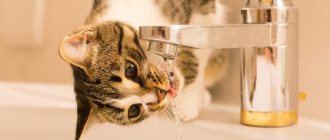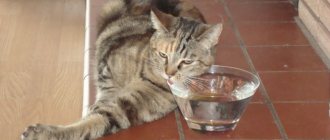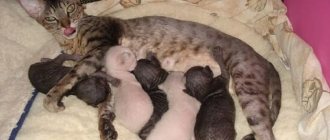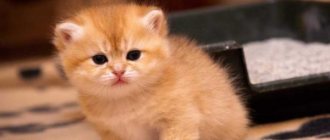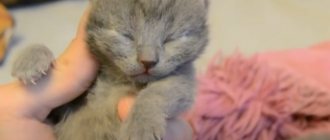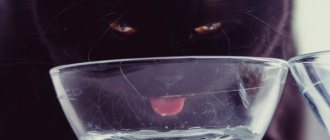If your cat's water breaks, this is a clear sign that labor is about to begin. At the same time, cats look excited, meow and look for a secluded place.
The owner must monitor this process in order to provide timely assistance to the expectant mother. If signs of complications are noticeable, it is recommended to contact a veterinary clinic or call a doctor at home.
What happens when your water breaks
As soon as the cat's water breaks, the next stage of labor begins - the onset of contractions.
At first the contractions are small and almost unnoticeable, then they intensify faster and stronger. Normal physiological childbirth in cats lasts no more than a day. At this time, you need to give your cat as much attention as possible. After all, especially for nulliparous women, this is a lot of stress and fear. Those who give birth for the first time, in a panic, they do not understand what is happening and may even eat their kitten.
If more than six hours have passed after the water has broken, sound the alarm and take the cat to the veterinary clinic. Most likely, veterinarian intervention is inevitable here.
If the process proceeds normally, then small, wet and blind kittens will soon be born. Usually, on the first day, the mother does not leave her cubs, licks them, purrs something and feeds them with her milk.
When is it a good idea to seek veterinary help?
Veterinary advice should be sought if you notice one or more of the following signs:
- Bleeding from the vagina or unusual discharge from the external genitalia.
- If you notice something “fleshy” sticking out of the animal’s external genitalia, this may indicate uterine prolapse. The pathology is very dangerous and can be treated (in many cases) surgically).
- Serious behavioral disturbances in a cat who gave birth. In normal cases, animals are not particularly active for about two weeks after birth: they spend most of the time caring for kittens and sleeping peacefully. But sometimes everything is not so “blessed”: with severe postpartum pathologies, cats sometimes kill and eat their own cubs. In addition, this happens when a basket with kittens and their mother is in a “passable” and noisy place. Therefore, try to provide your pet and its offspring with the most comfortable living conditions.
- Be sure to contact your veterinarian if you suspect mastitis in your cat. With this pathology, the animal's mammary glands become swollen and hot to the touch, and when you try to palpate them, your pet will experience severe pain.
General information
First you need to find out where these fluid flows that accompany the birth of kittens (and other mammals too) come from. In general, the so-called “water” is the contents of the amniotic sacs, in which each kitten is “wrapped” during growth and development in the uterus. This liquid is extremely. The sac is formed by two membranes called amnion and chorion. We are only interested in the amnion, since it is the aqueous membrane (which is removed during any normal childbirth).
The main task of the liquid shell is to protect the fruit from various impacts and injuries. It has excellent shock-absorbing properties, so the kittens are relatively reliably protected and may not be harmed even if a pregnant cat falls seriously.
In addition, the amnion plays the role of a kind of natural incubator, helping to maintain a strictly constant body temperature of kittens. Interestingly, the amniotic sac begins to form almost immediately after the fertilized egg “takes root” on the surface of the uterus.
The composition of amniotic fluid is not very diverse: basically, it is just water. But, starting from about the tenth week of pregnancy, water mixed with fetal urine begins to splash in the amniotic sac. So, by the time of birth, the “cocktail” in the placenta turns out to be very peculiar, which is why the cat’s waste water has a specific smell.
The volume of fluid in the amniotic cavity increases rather slowly, but this process accelerates noticeably starting from the eighth week of pregnancy. By this time, the fetuses are already sufficiently formed, their body is functioning normally, and therefore more urine is released. As a rule, the sac bursts on its own, directly during the second (active) stage of labor.
It is interesting that in cats, unlike in humans, cases of kittens being born “in a shirt” are quite common. Note that in situations where a baby is born wrapped in amniotic membranes, the cat must chew and eat them itself. If for some reason she cannot do this, this “honor” falls to the owner. True, there is no need to gnaw and eat the placenta; it is enough to simply free the kitten from it.
Notes
Thus, neither the breaking of water nor the birth of kittens in a “shirt” are pathologies. Moreover, all this is a completely natural process for cats when babies are born.
In addition, it is no less natural for a cat to eat the remains of the amniotic sac (and in the process, she drinks a certain amount of amniotic fluid) and you should not be afraid of this.
Your pet's digestion will also be fine. Moreover, eating the placenta enriches the cat’s body with hormones and other biologically active substances that “tune” it to the desired mood. And further. If for some reason a cat does not eat the placenta, it is subsequently much more likely to develop postpartum pathologies.
Veterinary practice, in particular, shows that in such animals, subinvolution of the uterus is much more often observed (that is, a pathology in which the organ does not return to its normal, prenatal size).
When does your water break and when should you expect labor?
So, the answer to the most important question: “When will labor begin if your waters have already broken?” If you have carefully read all of the above, then you already know that in cats this happens directly in the second stage of labor . The breaking of water accompanies the birth of each kitten. Sometimes the water may break at the end of the first stage. Simply put, in all normal cases this happens already at the moment the kittens are born, so you won’t have to wait long for a new addition.
Important! From the moment the water breaks, the kitten should be born within a maximum of 15-20 minutes (ideally no more than ten).
The more time the baby spends in the birth canal “dry,” the greater the likelihood of his death.
Most likely, the baby is stuck in the birth canal and therefore cannot be born naturally. In such situations, it is necessary to urgently call a veterinarian. The same must be done urgently in cases where there are no contractions, but the water has already broken!
Is it necessary to tear the “shirt” if the cat doesn’t do it? Yes need. But! It is to tear, and not to cut with a knife or scissors.
In the latter case, the likelihood that you will accidentally hit the kitten with a sharp blade is too high. Of course, this will not lead to anything good, since the cub may well die from massive bleeding in a couple of minutes. In addition, you should not “help” a cat give birth by pulling the kitten out of her while pulling on the amniotic sac. In these cases, the likelihood of harming the baby by damaging his limbs is too great. In a word, if a cat does not give birth, it is more advisable to immediately contact a specialist.
Finally, let’s discuss another opinion that is sometimes found among cat lovers: “Is it true that kittens born “with a shirt” are stronger than their peers?” Unfortunately, it is impossible to give an exact answer to this, since no serious research has been carried out in this area. But, rather, we are forced to disappoint supporters of this version: many veterinarians claim that among the kittens born “in a shirt,” on the contrary, there are many weakened and even premature individuals. This is quite easy to explain from a scientific point of view. If the calf was in the amniotic sac for too long, it may have developed hypoxia . Or the baby is initially very weakened, so much so that he doesn’t even make any attempts to get out of the bag on his own.
A little trick. It happens that for some reason the cat does not want to accept one of the kittens, does not feed him or lick him. In such cases, it is necessary to save the placenta of the other kitten, and then thoroughly wipe and dry the “refuser”. When his fur is a little dry, apply pieces of placenta and birth fluids from another baby onto it. After this, you can put the kitten on the cat again: there is a high probability that she will still accept it.
How long will it take for her to give birth?
The gestation period in cats lasts from 52 to 72 days. On average, cats bear kittens for about 65 days. When a cat's water breaks during normal pregnancy, she can give birth 6 hours later.
Conception occurs in an animal 2-3 days after mating. It is important to take into account the age of the animal and breed - cats with long hair wear it for up to 72 days, and animals with short hair wear it for up to 68 days.
If there are few kittens, then the cat can give birth earlier; with multiple births, labor begins later.
Progress of pregnancy
Very reminiscent of human pregnancy, because we are all mammals, and our bodies work very similarly. The only significant difference is the duration. How many days does it take for a cat to give birth? Typically, 59-66 days pass from the moment of conception, so you won’t have to wait long for the babies to appear. It is very difficult to determine more precisely, since sexual heat in cats begins long before ovulation and continues for some time after fertilization. Deviations are also possible. In rare cases, pregnancy may end prematurely, but in this case the kittens will not be viable. If the pregnancy is prolonged, then even more so the owner needs to know how many days later the cat gives birth. If pregnancy is delayed, this is a reason to urgently contact a veterinarian. A cat can carry kittens for a maximum of 66 days.
Physiological changes in the cat's body
They usually become noticeable in the third week, that is, approximately 21 days after mating. This period is important for diagnosis and correction of the period.
The papillae begin to redden and swell, they become rounded and raised. The abdomen becomes denser and harder, and brown flaking appears around the nipples.
The cat becomes drowsy and has an excellent appetite. If you see all these signs, then you can already confirm the date and find out exactly how long it will take for the cat to give birth.
The role of owners in the cat's birth process
As a rule, the birth of cute fluffy creatures takes place at home.
If there are no complications and everything is fine with the cat, then she is quite ready to give birth on her own, she does not need any outside help, even if she is bringing kittens for the first time. But in cases where there are even the slightest risks to the health of kittens or the expectant mother, it is better to go to a veterinary clinic, where doctors will reduce all possible threats to a minimum.
An important and necessary support for the animal will be the presence of caring owners, who must always be ready. Cats give birth approximately 60-70 days after conception, so there is plenty of time to prepare in any case.
Signs that the process of labor in the pet will soon intensify appear within a week.
You need to remain extremely attentive to your pregnant cat and constantly monitor her condition. If the animal gives birth repeatedly, then perhaps with some experience, recognizing feline signs of prenatal behavior is much easier. But how can you tell that a cat is giving birth when it’s her first time? What should the owner do to ensure that the furry pet gives birth without complications?
Helping a cat give birth
If everything goes well, then you should not interfere with the process, otherwise you can disturb her and she will eat her children. But sometimes complications can arise during childbirth in cats, and then you will have to provide her with help.
If a kitten is stuck in the birth canal, very carefully try to pull it out. But try not to hold him by the head at this time, because the baby’s cervical vertebrae are very fragile.
You need to hold it by the legs or folds of skin, alternately trying to pull in different directions. If the fluid has long since receded and the birth canal has become dry, then lubricate your fingers with Vaseline.
You need to drag along the body and never perpendicular to where the cat is lying. The owner can hold her by the abdomen with her other hand at this time. Try to do everything delicately and not use a lot of force, because it is easy not only to injure the kitten, but also to rupture the birth canal of its mother.
If the baby moves forward with his paws and gets stuck here, you can push him back. He can change his position and walk normally. The stuck placenta should be removed with your fingers. Sometimes the baby comes out in the birth bladder, then you need to break it, otherwise he may suffocate. Try to wipe his nose immediately so that the liquid does not get into his mouth.
Take the kitten nose down, holding the head with your fingers. You need to shake it at this moment so that the water leaves the lungs. Gentle vigorous rubbing of the baby's chest, which will replace artificial respiration, will also help here.
Normal breathing should be smooth and without any wheezing. A blue tongue can indicate a lack of oxygen. Wrap it in a clean, soft cloth and hold the kitten head down.
A faint squeak will tell you that he has begun to breathe on his own. Sometimes the cat does not chew the umbilical cord. Here you will need to pull it with a thread, about a couple of centimeters from the baby’s abdomen, and cut it with scissors, and treat the cut area with brilliant green or iodine.
Reason to urgently contact a veterinarian
In most cases, feline pregnancy goes smoothly, and at the appointed time, you will have a small furry family. But sometimes unforeseen complications arise, which is why it is important to know how many months later the cat will give birth. If the previously set date has passed and labor does not occur, this is a cause for concern. It is especially important not to delay if your furry pet is constantly looking for a place, meows pitifully, or refuses food for a long time. This behavior is normal during the birth process, but if you see that more than 10 hours have passed and the kittens are not appearing, then you need to urgently take her to the veterinarian.
Other signs that require immediate medical attention may include cat lethargy, vomiting and diarrhea, severe vaginal odor, and seizures. Don’t delay, because your pet’s life depends on it.
Behavior
It is very important to closely monitor the pregnant woman during the expected dates of birth of the kittens. A cat's behavior before giving birth can be the most unpredictable, but quite typical.
An attentive owner will always notice prenatal changes.
May be:
- almost constant purring and following on the heels of the owner. Murka literally requires increased attention;
- a clear call to follow her to the place where she is expected to give birth;
- when the due date approaches, try to find a secluded place and hide there, if a special place has not been equipped before this moment;
- for 10-12 hours, sitting without leaving in a place prepared by a person for newborns, it is impossible to call Murka from there;
- the cat looks tired, detached, and often does not eat anything;
- almost constantly licks his genitals;
- constantly lies down, but at the same time turns over from side to side, as if he cannot find a comfortable position;
- when meowing and attracting attention, it can look back at its stomach and show that something is starting (this is noticeable only to very attentive owners).
comments
Olga Oh, this is a sore topic for me... I’m standing at a crossroads - what should I do with a stray, apparently pregnant cat? Her belly is round, not downwards, but as if along the ribs. The nipples are dry, but somewhat obvious. Maybe she has already given birth before... I still haven’t figured out from her appearance what problems she is preparing for me... Ksenia According to my observation, pregnant cats become more affectionate. Ours, when she was in this position, constantly fawned over us and purred, although she is usually a rather capricious lady who will not climb into her arms again.
Lera Our cat was pregnant only once, we were very worried about her during this period of time. She slept constantly and moved little. The birth went without any problems, and she recovered very quickly.
Alina Everything is so informative
Duration of labor
Childbirth is divided into 3 phases. 1 and 2 alternately replace each other when the next kitten appears, and 3 goes the fastest and is the final stage.
- The cat's water broke. The beginning of the first uterine contractions. The appearance of contractions and an increase in the diameter of the perineum. Between contractions there are periods of calm.
- If you put your hand on a cat's belly, you can feel the kittens moving. The cat begins to breathe heavily and more often run to the box, rummaging through it. Primiparas experience this phase for about 36 hours.
- The frequency and pain of contractions is provoked by the imminent birth of the first baby. Strokes and kind words will calm the woman in labor. A small amount of fluid leaks from the ruptured amniotic membrane. The cat's pushing helps the baby's birth. Usually this process is accompanied by a growl or loud purring. The phase takes from 5 to 30 minutes. After the cat gives birth, she needs to gain strength. Therefore, it will not be superfluous to feed and water her. But she should not leave the place of birth.
After half an hour, when all the kittens have already been born, the cat's belly will become soft and elastic.
Problems that require a veterinarian
After the cat’s water breaks, the process is not long in coming and the animal begins to give birth. But there are a number of situations when you cannot do without the help of a qualified specialist. This is especially true for cat owners whose pet is giving birth for the first time. You need to be vigilant and call your doctor if any problems arise.
The main problems are:
- the duration of the initial stage of labor after the water breaks is more than 6 hours if the cat does not give birth;
- the appearance of strong contractions, the cry of the animal for more than 30 minutes without the birth of a kitten;
- prolonged contractions of the uterus for 10 minutes;
- water breaks and there are no contractions for 6-8 hours;
- the appearance of a kitten in a fluid-filled bladder stuck in the birth canal;
- feverish conditions of the animal;
- the appearance of severe hemorrhages (bleeding from the vagina) lasting more than 15 minutes;
- the appearance of thick, unpleasant-smelling, black discharge from the reproductive organs.
Necessary preparation
After successful conception, the formation of future kittens begins, which takes 60-65 days. During this time, it is recommended to find a veterinarian who is ready to provide emergency medical care at home in case of complications.
Arrangement of the place
During and after birth, the cat will need a secluded corner. It is better to prepare it in advance. Otherwise, the pet will hide under the sofa, which will prevent free access to her and the kittens. To build and equip a “maternity hospital” you will need:
Big box. Make sure that it will accommodate not only the new mother, but also her offspring.
Soft bedding or blanket. Place a disposable baby diaper under them to prevent the cardboard from getting wet.
Bowls for water and food. You also need to add a tray. After giving birth, the cat should rest and not run to the other end of the house to relieve itself.
The constructed space must be accessible and spacious. Isolate it from possible threats (children, other pets, drafts) by choosing the quietest and most secure room in the house.
Let's sum it up
Most often, the birth is easy and the cat does not need assistance. They are good mothers and very rarely abandon their babies. On the contrary, a cat will willingly adopt someone else's kitten, puppy or even a rat if they have become accustomed to each other since childhood. But always be on your guard. If specialist help is needed, it must be provided immediately, otherwise not only the lives of the babies, but also their mothers may be at risk. With the advent of a furry family, the owner has one more concern: finding a good new home for each baby.
